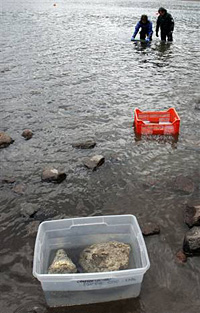 |
 |
 |
 News Around the Republic of Mexico | May 2007 News Around the Republic of Mexico | May 2007  
Possible Aztec Offerings Found in Mexico
 Mark Stevenson - Associated Press Mark Stevenson - Associated Press


| | Archaeologist Roberto Junco, left, and diver Fernando Lozano return with items found in the Nevado de Toluca volcano in Mexico. (Marco Ugarte/AP) |
Archaeologists diving into a lake in the crater of a snowcapped volcano found wooden scepters in the shape of lightning bolts that match the description by Spanish priests and conquerors writing 500 years ago about offerings to the Aztec rain god.

The lightning bolts — along with cones of copal incense and obsidian knives — were found during scuba-diving expeditions in one of the twin lakes of the extinct Nevado de Toluca volcano, at more than 13,800 feet above sea level.

Scientists must still conduct tests to determine the age of the findings, but the writings after the Spanish conquest in 1521 have led them to believe the offerings were left in the frigid lake west of Mexico City more than 500 years ago.

Lightning bolt scepters "were used by Aztec priests when they were doing rites associated with the god Tlaloc," said Johan Reinhard, an anthropologist and explorer-in-residence for National Geographic Society who took part in more dives Thursday at the Lake of the Moon. "We think it is pretty clear that the Aztecs considered this one of the more important places of Tlaloc."

The research, which also involves the volcano's Lake of the Sun, is being led by Mexico's National Institute of Anthropology and History. Stanislaw Iwaniszewski, an archaeology professor at the institute, said Aztec iconography often associates Tlaloc with lightning bolts.

"They were left in the lake to bring rain storms," Iwaniszewski said. Copal incense was burned to form "clouds," and sharp spines from the maguey cactus — which does not grow at that altitude — indicated worshippers brought them there to draw blood from themselves as part of the sacrifice.

Luis Alberto Martos, the institute's director of archaeological studies, said other artifacts found in the clear 32-degree waters of the lake indicate the ritual may have started about 100 B.C. — long before the Aztecas settled in the area in 1325. | 
 | |
 |



